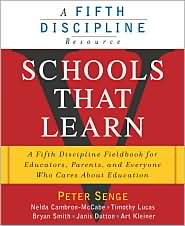
Over the course of the past two years I have, off and on, read the book Schools That Learn by Peter Senge. Initially I found the book extremely difficult to get through, and I really could not stand having to read it. It was only once I got past the initial chapter and primer and began to read the vignettes, when I began to see the value that this book held for me as an educator; especially as an educator that was currently in a situation where I was beginning to doubt my future in the field of education.
Last year I chose to focus more on the community aspect of the book, as it tied in very well with my EEVC; while this year my focus was spread between the Classroom and School sections. The topics that I have read recently were in the following subsections: Productive Classroom, School Vision and Current Reality. The following three paragraphs are my responses to three of the vignettes that I read. I found this vignettes to be the most meaningful to me at this time in my career.
“Educating All the City’s Children”
I teach in the inner city. The vignette, “Educating All the City’s Children” caught my attention for that very reason. The New York City school system is quite interesting, and in theory gives the students more opportunities than they would have in almost any other school district. While I was reading this vignette, I couldn’t help but think that the school system that they were designing was very similar to what we have here in NYC. The students and parents are given choices as to what type of curriculum they want their child to study, and what type of school they want their child to go to. Based on that information they have the opportunity to choose a school to fit their needs. I hope the goals laid out by the Memphis School District of having “high standards” for all students are upheld and do now end up falling by the wayside as they did in NYC.
“Triangle of Design, Circle of Culture”
I teach in New York City. My school is not the greatest. In fact it is far from it! To remedy this situation the NYC DOE has created a system of Checks and Balances (if you will) to identify what schools (we are not just talking about my school we are talking about the 1,499 schools citywide) that are in need of added assistance. This vignette explains that “a school’s culture is not static” and gives examples of what a healthy school community looks like. As I read these examples, I could not help but feel more frustrated in my current position. For almost each and every item, my school does the opposite.
“Shifting the Burden”
“Teaching to the test,” is a term that is heard in many schools. The writers of this section addressed the way that many schools view standardized tests, and how they tackle this preparation through their curriculum. The fact of the matter is that because of the way that the tests are put forth, often schools feel that their only course of action is the “quick fix”. In this scenario (which should seem all too familiar to many) once testing nears, schools turn their classes into test-prep factories. The writers show that while this solution does work to a certain extent, it is not wholly effective. In the end, everyone ends up getting hurt. In my school, come the middle of November they decide that it is time to begin prepping for the NYS ELA exam. At that point the regular curriculum gets put away and all that is done is straight test-prep. A new prototype is given out to all teachers (even those that do not teach ELA). This prototype tells us what must be done at all times. For example, on Monday we focus on multiple choice strategies, on Tuesday we focus on short answer questions . . . even non-ELA teachers are required to follow this rigid test-prep schedule. Any deviation from the schedule you risk being written up. Finally the writers present a less forceful approach, which they call the fundamental solution loop. While the long-term effects of this model are better, the fact that it takes a while to reach these effects, many schools, like mine, opt for the “quick fix.” In the fundamental solution loop the schools aren’t necessarily “teaching to the test,” but paving “the way for longer-term investments in student learning.”


